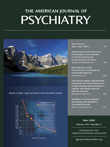The Can-SAD Study: A Randomized Controlled Trial of the Effectiveness of Light Therapy and Fluoxetine in Patients With Winter Seasonal Affective Disorder
Abstract
Objective: Light therapy and antidepressants have shown comparable efficacy in separate studies of seasonal affective disorder treatment, but few studies have directly compared the two treatments. This study compared the effectiveness of light therapy and an antidepressant within a single trial. Method: This double-blind, randomized, controlled trial was conducted in four Canadian centers over three winter seasons. Patients met DSM–IV criteria for major depressive disorder with a seasonal (winter) pattern and had scores ≥23 on the 24-item Hamilton Depression Rating Scale. After a baseline observation week, eligible patients were randomly assigned to 8 weeks of double-blind treatment with either 1) 10,000-lux light treatment and a placebo capsule, or 2) 100-lux light treatment (placebo light) and fluoxetine, 20 mg/day. Light treatment was applied for 30 minutes/day in the morning with a fluorescent white-light box; placebo light boxes used neutral density filters. Results: A total of 96 patients were randomly assigned to a treatment condition. Intent-to-treat analysis showed overall improvement with time, with no differences between treatments. There were also no differences between the light and fluoxetine treatment groups in clinical response rates (67% for each group) or remission rates (50% and 54%, respectively). Post hoc testing found that light-treated patients had greater improvement at 1 week but not at other time points. Fluoxetine was associated with greater treatment-emergent adverse events (agitation, sleep disturbance, palpitations), but both treatments were generally well-tolerated with no differences in overall number of adverse effects. Conclusions: Light treatment showed earlier response onset and lower rate of some adverse events relative to fluoxetine, but there were no other significant differences in outcome between light therapy and antidepressant medication. Although limited by lack of a double-placebo condition, this study supports the effectiveness and tolerability of both treatments for seasonal affective disorder and suggests that other clinical factors, including patient preference, should guide selection of first-line treatment.



